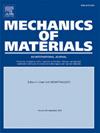Electroelastically coupled stiffness matrix method for phononic crystals with piezoelectric defects and its applications to filters, sensors, and energy harvesters
IF 3.4
3区 材料科学
Q2 MATERIALS SCIENCE, MULTIDISCIPLINARY
引用次数: 0
Abstract
This study presents a comprehensive analytical framework for one-dimensional phononic crystals (PnCs) integrated with piezoelectric defects, leveraging an electroelastically coupled stiffness matrix under longitudinal wave propagation. This matrix effectively captures the mechanical coupling between defects and piezoelectric devices, as well as the piezoelectric coupling within the devices, providing a robust foundation for predicting key behaviors such as band structures, defect mode shapes, and frequency responses. The stiffness matrix method employed in this study overcomes the numerical instabilities inherent in traditional transfer matrix approaches, thereby enhancing the reliability and precision of the framework. The versatility of the proposed framework is evident in its application across diverse engineering domains, including tunable bandpass filters, high-sensitivity ultrasonic sensors, and energy harvesters. The accuracy of the model is validated through finite-element simulations, which demonstrates significantly reduced computation times. To encourage further research and practical implementation, the study provides MATLAB codes. This study establishes the foundation for extending the framework to bending waves, miniaturized PnCs, and oblique wave propagation scenarios.

压电缺陷声子晶体的电弹性耦合刚度矩阵法及其在滤波器、传感器和能量收集器中的应用
本研究利用纵波传播下的电弹性耦合刚度矩阵,提出了具有压电缺陷的一维声子晶体(PnCs)的综合分析框架。该矩阵有效地捕获了缺陷和压电器件之间的机械耦合,以及器件内部的压电耦合,为预测关键行为(如能带结构、缺陷模态形状和频率响应)提供了坚实的基础。本文采用的刚度矩阵法克服了传统传递矩阵法固有的数值不稳定性,从而提高了框架的可靠性和精度。所提出的框架的多功能性在其在不同工程领域的应用中是显而易见的,包括可调谐带通滤波器,高灵敏度超声波传感器和能量采集器。通过有限元仿真验证了模型的准确性,大大减少了计算量。为了鼓励进一步的研究和实际实施,本研究提供了MATLAB代码。本研究为将框架扩展到弯曲波、小型化pnc和斜波传播场景奠定了基础。
本文章由计算机程序翻译,如有差异,请以英文原文为准。
求助全文
约1分钟内获得全文
求助全文
来源期刊

Mechanics of Materials
工程技术-材料科学:综合
CiteScore
7.60
自引率
5.10%
发文量
243
审稿时长
46 days
期刊介绍:
Mechanics of Materials is a forum for original scientific research on the flow, fracture, and general constitutive behavior of geophysical, geotechnical and technological materials, with balanced coverage of advanced technological and natural materials, with balanced coverage of theoretical, experimental, and field investigations. Of special concern are macroscopic predictions based on microscopic models, identification of microscopic structures from limited overall macroscopic data, experimental and field results that lead to fundamental understanding of the behavior of materials, and coordinated experimental and analytical investigations that culminate in theories with predictive quality.
 求助内容:
求助内容: 应助结果提醒方式:
应助结果提醒方式:


